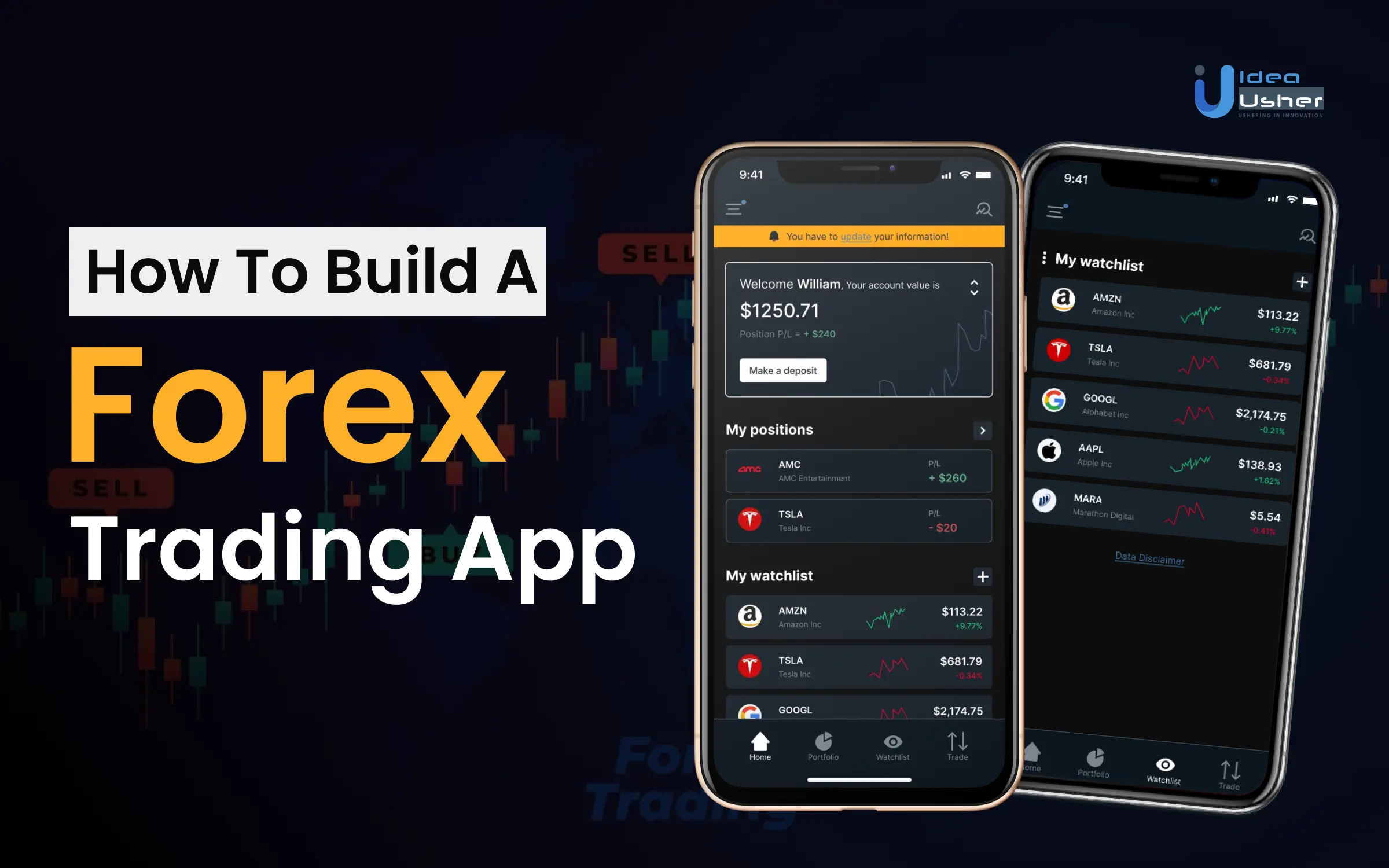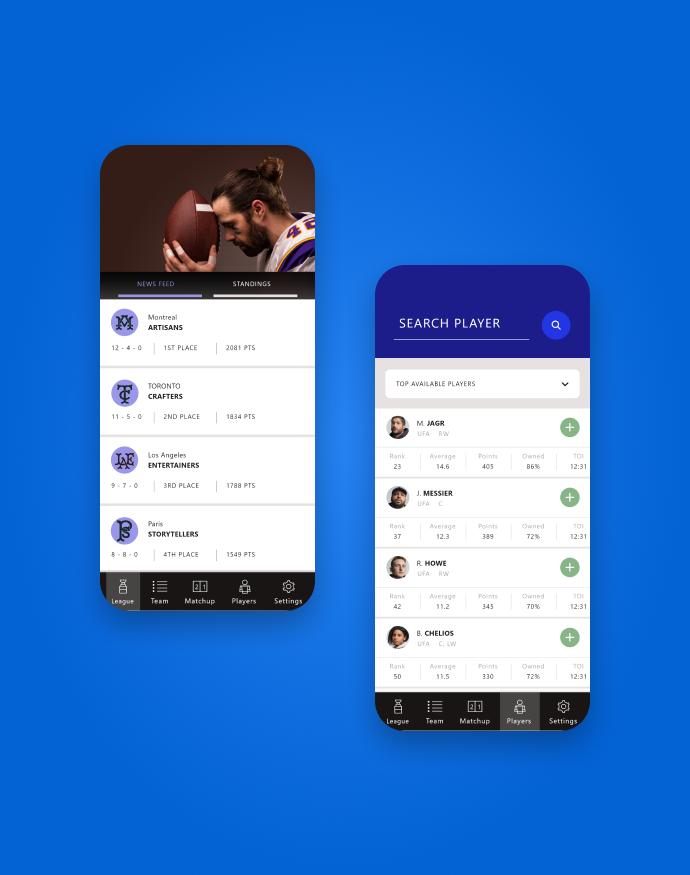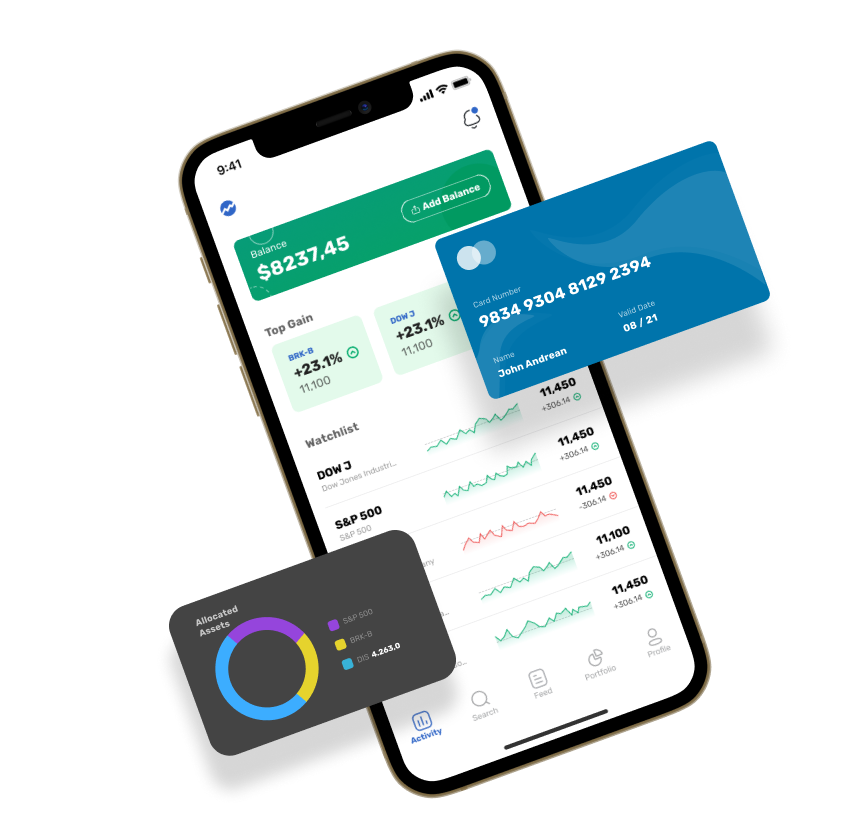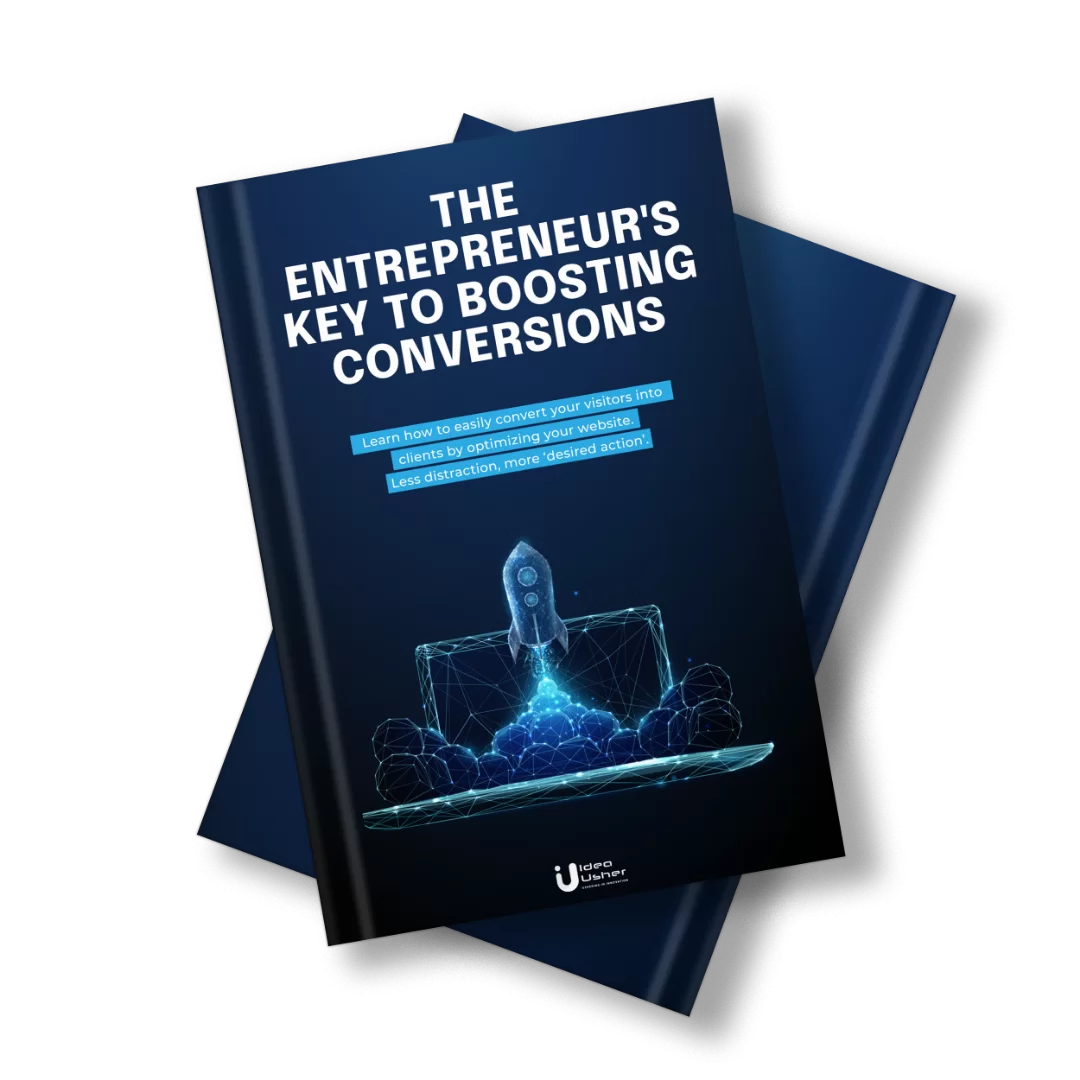- What is a Forex Trading App?
- Types of Forex Trading Apps
- How Does a Forex Trading App Work?
- Why Dive into the World of Forex Trading Apps?
- Must-Have Features for a Forex Trading App?
- Forex Trading Apps: Market Growth Analysis
- Development Steps to a Forex Trading App
- Cost Affecting Factors for Forex Trading App Development
- Essential Tech Stack Needed to Develop a Forex Trading App
- Top 10 Forex Trading Apps
- Conclusion
- Frequently Asked Questions

In today’s dynamic financial landscape, Forex trading has surged in popularity, and at the heart of this surge lies the Forex trading app. These digital platforms have revolutionized how traders participate in the global currency markets. But have you ever wondered what it takes to build one?
In this blog, we’ll talk about Forex trading app development, shed light on must-have features, as well as explore the essential tech stack needed in order to develop a Forex trading app. Let’s embark on this journey to understand the intricacies of building a Forex trading app from the ground up.
- What is a Forex Trading App?
- Types of Forex Trading Apps
- How Does a Forex Trading App Work?
- Why Dive into the World of Forex Trading Apps?
- Must-Have Features for a Forex Trading App?
- Forex Trading Apps: Market Growth Analysis
- Development Steps to a Forex Trading App
- Cost Affecting Factors for Forex Trading App Development
- Essential Tech Stack Needed to Develop a Forex Trading App
- Top 10 Forex Trading Apps
- Conclusion
- Frequently Asked Questions
What is a Forex Trading App?
A Forex trading app is a specialized mobile application designed to facilitate the buying as well as selling of foreign currencies in the global foreign exchange (Forex) market. These apps provide traders with real-time access to currency exchange rates, charts, news, and analysis tools, allowing them to make informed decisions about when as well as how to trade currencies.
Forex trading apps are popular among both novice as well as experienced traders due to their convenience, accessibility, and the ability to execute trades on the go. They often offer a range of features such as live market data, and technical indicators, as well as the ability to place and manage trades directly from a mobile device, thus, making them an essential tool for anyone involved in the Forex market.
Types of Forex Trading Apps
Forex trading apps can be categorized based on several factors, including the platform, target audience, as well as purpose. Here’s a breakdown of these categories to help you decide the type of app you’d like to create:
Based on the Platform:
Mobile Apps: Mobile Forex trading apps are designed for smartphones as well as tablets. They offer the advantage of trading on the go, thus, making them popular among traders who require flexibility and accessibility. Mobile apps should have an intuitive user interface, real-time data, as well as seamless execution of trades. They cater to both beginners and experienced traders who prefer the convenience of trading from their mobile devices.
Web Apps: Web-based Forex trading platforms run in web browsers without the need for downloading or installing software. They are versatile as well as accessible from any device with an internet connection. Web apps are favored by traders who want a consistent trading experience across different devices as well as operating systems. They are typically user-friendly and offer essential trading tools and features.
Based on Targeted Investors:
Beginner-Friendly Apps: These apps are tailored for novice traders who are just starting in the Forex market. They often provide educational resources, tutorials, as well as demo accounts for practice. The user interface is simplified, thus, making it easy for beginners to understand and navigate.
Intermediate Trader Apps: Intermediate-level apps cater to traders who have gained some experience in Forex trading. They offer a broader range of technical analysis tools, advanced charting features, as well as access to more currency pairs. These apps strike a balance between simplicity and complexity, thus, helping traders in order to expand their skills.
Advanced Trader Apps: These apps are designed for experienced as well as professional traders. They provide sophisticated tools for technical and fundamental analysis, customizable trading strategies, as well as advanced risk management features. Advanced trader apps are often favored by institutional traders as well as those engaging in high-frequency trading.
Based on Purpose:
Automated Trading Apps: These apps are designed for traders who prefer algorithmic or automated trading strategies. They often integrate artificial intelligence (AI) as well as machine learning algorithms in order to make trading decisions on behalf of the user. Traders can set specific parameters, as well as the app executes trades based on predefined rules.
High-Frequency Trading Apps: High-frequency trading apps are engineered for lightning-fast execution of trades. They are designed to capitalize on minute price movements as well as are typically used by professional traders and institutions. These apps require robust technology infrastructure in order to support rapid trading.
Long-Term Investment Apps: Some traders prefer a hands-off approach and opt for long-term investment apps. These apps provide tools for fundamental analysis, portfolio management, as well as tracking long-term trends. They cater to investors looking to build wealth over an extended period.
How Does a Forex Trading App Work?
Forex trading apps have become indispensable tools for traders looking to participate in the world’s largest financial market. But how do these apps work? Let’s dive into the mechanics of a Forex trading app to demystify its functionality.
Real-time Data Feeds:
Forex trading apps provide traders with access to real-time market data. This includes currency exchange rates, charts, as well as other relevant information. The data comes from various sources and is crucial in order to make informed trading decisions. Traders can monitor price movements, track historical data, as well as analyze trends directly from their mobile devices.
User-friendly Interface:
Forex trading apps are designed with user-friendliness in mind. They offer intuitive interfaces that make it easy for traders of all levels of expertise to navigate as well as execute trades. This includes features such as customizable charts, technical indicators, as well as order placement options.
Order Execution:
When a trader decides to enter a trade, the Forex trading app facilitates the process by allowing them to place market orders, limit orders, or stop-loss orders. These orders are executed electronically, thus, connecting the trader to the global Forex market. The app sends the order to a broker or liquidity provider, who then matches it with a counterparty.
Access to Forex Brokers:
Most Forex trading apps are associated with reputable Forex brokers. Users typically need to create an account with a broker, as well as the app acts as a bridge between the trader and the broker’s trading platform. This connection allows traders to access a wide range of currency pairs as well as trade with leverage.
Technical Analysis Tools:
Forex trading apps often come equipped with a variety of technical analysis tools. Traders can apply indicators, oscillators, as well as drawing tools to their charts, thus, helping them make better-informed trading decisions. Additionally, these apps can generate trading signals based on technical analysis patterns.
Risk Management Features:
Managing risk is a critical aspect of Forex trading. Forex trading apps offer risk management features such as stop-loss and take-profit orders. These tools help traders set predefined levels at which their positions will automatically close to limit potential losses or lock in profits.
News and Analysis:
Staying informed about market news as well as events is essential for Forex traders. Many trading apps provide access to real-time news feeds, economic calendars, as well as market analysis. This information can help traders anticipate market movements as well as make strategic decisions.
Mobile Trading:
One of the primary advantages of Forex trading apps is the ability to trade on-the-go. Traders can access their accounts and execute trades from anywhere with an internet connection. This flexibility allows for greater responsiveness to changing market conditions.
Security and Encryption:
Security is a top priority for Forex trading apps. They use encryption and authentication protocols to protect users’ personal and financial information. This ensures that trading is secure, and funds remain safe within the app.
Why Dive into the World of Forex Trading Apps?
The ever-expanding realm of forex trading presents a compelling opportunity for app developers. But before taking the plunge, it’s crucial to weigh the potential rewards against the inherent challenges. Let’s delve into the factors that make developing a forex trading app an attractive proposition, alongside the hurdles you’ll need to navigate.
Why Building a Forex App Can Be Beneficial:
- Big Market, Big Potential: The forex market is HUGE, with trillions of dollars traded every day. A unique app could attract a lot of users!
- People Love Mobile Money: More and more people, especially younger folks, use their phones for everything, including money stuff. Your app could be a perfect fit!
- Open the Door to New Traders: Apps can make forex trading easier for beginners, bringing in new people who might not have tried it before.
- Make Money, Make Money! You can earn cash through fees, premium memberships, or selling extra features within the app.
- Brand Booster: A popular app can make your company look great, attracting investors and partners.
But There Are Challenges Too:
- Standing Out is Tough: There are already lots of forex apps out there. You’ll need something special to grab users’ attention.
- Tech Savvy Required: Building a safe, reliable, and easy-to-use app takes some serious tech skills and resources.
- Rules and Regs: Dealing with financial regulations and keeping things secure can be tricky and expensive.
- Help Users Avoid Risk: Forex trading can be risky. Your app needs features to help users manage risk and avoid losing money.
- Keeping Up is Key: The financial world moves fast! You’ll need to constantly update your app to stay relevant.
Must-Have Features for a Forex Trading App?
If you’re considering using or developing a Forex trading app, here are some must-have features that can enhance your trading experience and improve your chances of success:
1. Real-time Market Data:
Accurate and up-to-date market data is the lifeblood of Forex trading. A reliable trading app should offer real-time currency exchange rates, charts, and historical data. Ensure that the data feed is fast and uninterrupted to make timely decisions.
2. User-Friendly Interface:
A user-friendly interface is crucial for traders of all levels. The app should be intuitive and easy to navigate, allowing users to access various features effortlessly. Customizable charts, technical indicators, and order placement should be easily accessible.
3. Multiple Currency Pairs:
A robust Forex trading app should support a wide range of currency pairs. The major pairs like EUR/USD, GBP/USD, and USD/JPY are essential, but access to minor and exotic pairs is also important for diversification.
4. Order Types:
The app should support various order types, including market orders, limit orders, and stop-loss orders. Advanced order types like trailing stops can also be valuable for risk management and strategy implementation.
5. Technical Analysis Tools:
Technical analysis is a fundamental part of Forex trading. Look for an app that offers a comprehensive set of technical analysis tools, such as trendlines, indicators (like moving averages and RSI), and drawing tools.
6. News and Analysis:
Access to breaking news and in-depth market analysis can be a game-changer. A trading app with an integrated news feed and economic calendar keeps traders informed about events that could impact currency movements.
7. Risk Management Features:
Effective risk management is essential in Forex trading. The app should allow users to set stop-loss and take-profit levels easily. Trailing stops, which automatically adjust as the trade moves in your favor, are another valuable feature for protecting profits.
8. Demo Account Support:
For beginners or traders looking to test their strategies, a demo account feature is indispensable. It allows users to trade with virtual funds to practice without risking real money.
9. Security and Authentication:
Security is paramount in Forex trading apps. Ensure the app uses strong encryption protocols to protect user data and transactions. Two-factor authentication (2FA) adds an extra layer of security to user accounts.
10. Mobile Accessibility:
A Forex trading app should be available on multiple mobile platforms, including iOS and Android. Traders need to access their accounts and execute trades from their smartphones and tablets, ensuring they don’t miss opportunities while on the move.
11. Account Management:
A comprehensive account management section should enable users to deposit as well as withdraw funds easily. Transparent reporting of account balances, transaction history, and performance analytics can help traders make informed decisions.
12. Customer Support:
Reliable customer support is crucial, especially when traders encounter issues or have questions. Look for apps with responsive customer support channels, such as live chat or email support.
13. Social Trading Integration:
Some trading apps offer social trading features, thus, allowing users to follow and copy the trades of experienced traders. This can be a valuable learning tool as well as a way to diversify your trading strategy.
Forex Trading Apps: Market Growth Analysis
The Forex trading app market is on an impressive growth trajectory, with a projected global compound annual growth rate of 6.4%. This expansion is set to propel the market from approximately 10.21 billion U.S. dollars in 2022 to an estimated 13.3 billion U.S. dollars by 2026. The increasing demand for convenient as well as accessible ways to trade currencies, coupled with technological advancements and a growing interest in financial markets, is driving this remarkable growth in the online trading sector. Forex trading apps are at the forefront of this evolution, thus, offering traders a seamless as well as user-friendly way to participate in the global Forex market.
Development Steps to a Forex Trading App
Let’s dive deeper into each development step involved in creating a Forex trading app:
1. Market Research and Planning:
- Define Your Objectives: Specify whether your app is designed for retail traders, professional investors, or a niche market. Determine whether you aim to offer advanced trading features, educational content, or other unique selling points.
- Market Analysis: Perform thorough market research to identify competitors, target demographics, and market trends. Understand the regulatory landscape in the regions you plan to operate.
2. Regulatory Compliance:
- Licensing and Regulations: Research and comply with the regulations governing Forex trading in your target regions. Ensure you have the necessary licenses and approvals from relevant authorities.
- AML and KYC: Implement robust Anti-Money Laundering (AML) and Know Your Customer (KYC) procedures to verify user identities and prevent illicit activities.
3. Technology Stack Selection:
- Trading Platform: Select a trading platform or API to access Forex markets. Consider whether you’ll offer MetaTrader, cTrader, or other popular platforms.
- Development Tools: Choose the right development tools and libraries for efficient coding and testing. Version control systems like Git are essential for collaboration among developers.
4. User Interface (UI) and User Experience (UX) Design:
- Wireframing and Prototyping: Create detailed wireframes and interactive prototypes to visualize the app’s layout and flow. Prioritize user-friendliness and intuitive navigation.
- Responsive Design: Ensure the app’s design adapts seamlessly to various devices, screen sizes, and orientations.
5. Back-End Development:
- Data Integration: Develop APIs to connect your app to Forex data providers and liquidity providers. Implement WebSocket or other real-time data feeds for currency pairs, charts, and order book updates.
- Algorithmic Trading: If supporting algorithmic trading, code and integrate trading algorithms, including trend-following, scalping, or arbitrage strategies.
- Security Measures: Implement encryption, secure authentication, and authorization mechanisms to safeguard user data and financial transactions.
6. Front-End Development:
- Trading Features: Implement features for users to place various types of orders (market, limit, stop), modify or cancel orders, and monitor open positions.
- Charting: Develop interactive and customizable charting tools with indicators, overlays, and drawing capabilities.
- Account Management: Allow users to manage their accounts, view balances, margins, transaction history, and generate reports.
7. Testing:
- Unit Testing: Conduct unit tests to ensure the correctness of algorithms, data processing, and other individual components.
- Integration Testing: Test interactions between different modules, APIs, and external data sources.
- User Acceptance Testing (UAT): Invite beta testers and actual users to participate in UAT to gather feedback and identify usability issues.
8. Risk Management:
- Stop-Loss and Take-Profit: Implement stop-loss and take-profit functionalities to help users manage their risk and define profit targets.
- Risk Analysis: Develop risk assessment algorithms to provide users with risk metrics and warning notifications based on their trading activity.
9. Performance Optimization:
- Optimize app performance for low latency and fast execution by minimizing network delays and optimizing database queries.
- Use caching mechanisms to reduce load on servers and enhance user experience during peak trading times.
10. Deployment:
- Host your trading app on secure and scalable cloud infrastructure, ensuring high availability and reliability.
- Implement auto-scaling to handle increased traffic and load balancing for efficient resource allocation.
11. Monitoring and Maintenance:
- Set up continuous monitoring of server health, app performance, and security using tools like Prometheus and Grafana.
- Establish a maintenance schedule for regular updates, bug fixes, and security patches.
12. Compliance and Reporting:
- Generate and store transaction reports, account statements, and tax-related documents for compliance and regulatory purposes.
- Periodically audit your app to ensure ongoing compliance with changing regulations.
13. Marketing and User Acquisition:
- Develop a comprehensive marketing strategy, including online advertising, content marketing, SEO, and social media promotion.
- Consider offering demo accounts, webinars, or educational resources to attract and engage users.
14. Customer Support:
- Provide multiple channels for customer support, including live chat, email, and phone support, to assist users with inquiries, technical issues, and account-related matters.
- Offer a knowledge base or FAQ section for self-help resources.
15. Feedback and Iteration:
- Establish mechanisms for collecting user feedback through in-app surveys, customer support interactions, and user forums.
- Continuously analyze user data and feedback to prioritize and plan iterative updates, feature enhancements, and bug fixes.
- Building a Forex trading app is a complex and multifaceted endeavor. Collaboration with experienced developers, financial experts, compliance officers, and user experience designers is essential for success in this highly regulated and competitive industry. Additionally, staying informed about evolving market trends and regulations is crucial to adapting your app and business strategy accordingly.
Cost Affecting Factors for Forex Trading App Development
Developing a Forex trading app is a complex endeavor that involves various factors influencing the overall cost. Understanding these cost-affecting factors is essential in order to plan your project budget. Here are the key elements that can impact the cost of Forex trading app development:
App Complexity:
The complexity of your app’s features and functionalities significantly impacts development costs. Basic apps with limited features will cost less than advanced apps with automated trading, complex analytics, as well as AI integration.
Platform Choice:
Developing for multiple platforms (iOS, Android, and web) increases costs compared to targeting a single platform. The choice between native app development as well as cross-platform development also affects expenses.
User Interface (UI) and User Experience (UX) Design:
A well-designed, user-friendly interface is essential for a trading app’s success. Investing in professional UI/UX design can raise development costs, however, it enhances the app’s appeal and usability.
Real-Time Data Integration:
Access to real-time market data is crucial for a Forex trading app. Costs can rise depending on the data sources you choose, the number of assets you track, as well as the frequency of data updates.
Technical Analysis Tools:
Implementing advanced technical analysis tools, such as customizable charts, multiple indicators, and drawing tools, can add to development costs.
Trading Features:
Features such as order placement, risk management tools (e.g., stop-loss and take-profit orders) and algorithmic trading capabilities can increase development expenses.
Security Measures:
Ensuring the security of user data as well as transactions is paramount. Robust encryption, authentication mechanisms, as well as regular security audits contribute to development costs.
Regulatory Compliance:
Forex trading apps must comply with financial regulations, which may vary by region. Compliance efforts, including legal consultations as well as necessary adjustments, can add to expenses.
Backend Development:
A robust back-end infrastructure for handling transactions, user accounts, as well as data processing is essential. The complexity of the back-end architecture can affect costs.
Testing and Quality Assurance:
Rigorous testing and quality assurance are vital in order to identify and resolve issues. The extent of testing, including manual as well as automated testing, and consequently, can impact project costs.
Data Providers and APIs:
Costs may arise from integrating with data providers as well as third-party APIs for real-time market data as well as analytics.
Deployment and Maintenance:
Deploying the app on app stores, maintaining server infrastructure as well as releasing updates incur ongoing costs after the initial development phase.
Development Team:
The size and expertise of your development team play a significant role in cost determination. Highly skilled developers as well as designers typically command higher rates.
Project Timeline:
The timeline for app development can influence costs. Rushed development schedules may require additional resources as well as increased expenses.
Post-Launch Expenses:
Marketing, user acquisition, as well as ongoing support can incur significant post-launch expenses.
Scalability:
Planning for future scalability may require building a more robust infrastructure, which can increase initial development costs, however, provide long-term benefits.
Essential Tech Stack Needed to Develop a Forex Trading App
Developing a Forex trading app requires a robust tech stack in order to ensure its functionality, reliability, as well as security. Here are the essential components of the tech stack for building a Forex trading app:
Front-End Development:
- Programming Languages: Choose from JavaScript, TypeScript, or Swift for mobile app development. HTML/CSS and JavaScript frameworks like React, Angular, or Vue.js are suitable for web apps.
- UI/UX Design Tools: Adobe XD, Sketch, Figma, or InVision for creating intuitive and user-friendly interfaces.
- Mobile Development (if applicable): Use platforms like React Native, Flutter, or native development for iOS and Android apps.
Back-End Development:
- Server-Side Programming Languages: Python, Node.js, Java, or C# are popular choices for the back-end.
- Web Frameworks: Express.js, Django, Spring Boot, or ASP.NET Core for building web services.
- Database Management: Choose relational databases like PostgreSQL or MySQL for transactional data and NoSQL databases like MongoDB for real-time data storage.
- RESTful APIs: Develop APIs for data retrieval, order execution, and user management.
Real-Time Data Integration:
- WebSocket Protocol: Implement WebSocket connections for real-time market data streaming and updates.
- API Providers: Integrate with trusted Forex market data providers like MetaTrader, OANDA, or ForexFeed to access accurate and up-to-date exchange rates and market information.
Trading Functionality:
- Algorithmic Trading Framework: If your app offers automated trading, consider using platforms like MetaTrader 4/5, Zipline, or custom algorithmic trading libraries.
- Risk Management Tools: Develop features for setting stop-loss and take-profit orders, margin calculations, and position management.
Technical Analysis Tools:
- Charting Libraries: Integrate charting libraries like D3.js, Highcharts, or TradingView for interactive and customizable price charts.
- Technical Indicators: Implement popular technical indicators like Moving Averages, RSI, MACD, and Bollinger Bands.
Security Measures:
- Data Encryption: Use SSL/TLS encryption for secure data transmission.
- Authentication: Implement strong user authentication with features like multi-factor authentication (MFA).
- Data Security: Regularly audit and update security protocols to protect user data and transactions.
- Firewalls and Intrusion Detection Systems (IDS): Add layers of security to protect against threats and breaches.
Cloud Services:
- Hosting: Utilize cloud hosting services like AWS, Azure, or Google Cloud for scalability and reliability.
- Content Delivery: Use CDN (Content Delivery Networks) to ensure fast content delivery to users globally.
Testing and Quality Assurance:
- Testing Tools: Employ testing frameworks like Jest, Selenium, or Appium for functional and compatibility testing.
- Continuous Integration (CI) and Continuous Deployment (CD): Automate the testing and deployment process to maintain code quality.
Analytics and Monitoring:
- Analytics Tools: Integrate analytics tools like Google Analytics or Mixpanel to track user behavior and app performance.
- Logging and Monitoring: Use tools like Loggly, Sentry, or Prometheus to monitor server and app performance, detect issues, and troubleshoot.
Regulatory Compliance:
- Regulatory Tools: Implement tools and processes for compliance with financial regulations and reporting requirements.
Mobile App Platforms (if applicable):
- iOS Development: Xcode, Swift, and Objective-C for iOS app development.
- Android Development: Android Studio, Kotlin, and Java for Android app development.
DevOps Tools:
- Version Control: Git and platforms like GitHub or GitLab for code versioning and collaboration.
- Containerization: Docker for containerization and Kubernetes for container orchestration.
- Deployment: Tools like Jenkins or Travis CI for automated deployment.
Top 10 Forex Trading Apps
Here’s a selection of the top 10 apps that cater to traders’ diverse needs:
1. MetaTrader 4 (MT4):
- Platform: iOS, Android, Windows
- Overview: MetaTrader 4 is a highly popular and widely used Forex trading app known for its user-friendly interface, customizable charts, as well as a vast library of technical indicators. It offers real-time market data, and automated trading options, and is favored by both beginners and experienced traders.
2. MetaTrader 5 (MT5):
- Platform: iOS, Android, Windows
- Overview: Building upon the success of MT4, MetaTrader 5 offers additional features, including more timeframes, more technical indicators, and support for a wider range of assets, such as stocks and commodities.
3. TradingView:
- Platform: iOS, Android, Web
- Overview: TradingView is a web-based platform known for its advanced charting capabilities and extensive social networking features. Traders can share ideas, analyses, and strategies with a vibrant community while accessing powerful technical analysis tools.
4. IG Trading:
- Platform: iOS, Android, Web
- Overview: IG Trading offers a comprehensive trading experience, including access to a wide range of markets, real-time news updates, and customizable alerts. It’s suitable for both beginners and advanced traders.
5. OANDA:
- Platform: iOS, Android, Web
- Overview: OANDA’s app provides access to an extensive selection of currency pairs and precious metals. It offers historical exchange rate data and advanced charting tools, making it appealing to traders interested in thorough analysis.
6. Forex.com:
- Platform: iOS, Android, Web
- Overview: Forex.com offers a user-friendly trading app with access to a broad range of markets, including Forex, commodities, and indices. It provides comprehensive research and analysis tools to aid traders in decision-making.
7. Thinkorswim:
- Platform: iOS, Android
- Overview: Thinkorswim is TD Ameritrade’s trading platform, offering a feature-rich mobile app for Forex and other asset classes. It stands out for its advanced charting tools and technical analysis capabilities.
8. cTrader:
- Platform: iOS, Android, Web
- Overview: cTrader is known for its intuitive interface and advanced charting features. It offers Level II pricing and supports algorithmic trading, making it a favorite among experienced traders.
9. Plus500:
- Platform: iOS, Android, Web
- Overview: Plus500 is a straightforward and user-friendly trading app. It offers a wide range of assets, including Forex, stocks, and cryptocurrencies. The app is known for its simple design and ease of use.
10. eToro:
- Platform: iOS, Android, Web
- Overview: eToro is a social trading platform that allows users to follow and copy the trades of experienced traders. It’s an excellent choice for beginners looking to learn from others while participating in Forex trading.
Conclusion
In conclusion, building a Forex trading app is a multifaceted endeavor that demands careful planning, technological expertise, and a deep understanding of the dynamic Forex market. To succeed, you must prioritize user experience, security, as well as regulatory compliance while tailoring features to meet the needs of your target audience. The choice of technology stack, development platform, as well as adherence to best practices are critical in order to deliver a robust and reliable app. Moreover, continuous improvement and adaptation to market trends are essential for staying competitive. With a well-executed strategy as well as the right development team, a Forex trading app can provide traders with a powerful tool in order to navigate the complex world of currency trading.
Ready to take your Forex Trading App to the next level? Look no further! At IdeaUsher, we excel in both front-end and back-end development, and our team of experts is here to make your vision a reality.
Let’s build the perfect Forex Trading App together. Contact us today to get started!
Frequently Asked Questions
Q. Which programming languages and frameworks are commonly used for Forex trading app development?
A. Commonly used programming languages such as JavaScript, TypeScript, Python, as well as Java. Frameworks such as React Native, Flutter, Express.js, as well as Django are popular choices for developing Forex trading apps.
Q. How can I ensure the security of my Forex trading app and user data?
A. To enhance security, employ data encryption, implement strong authentication methods, regular security audits, as well as follow best practices for secure coding. Compliance with regulatory standards is also crucial.
Q. What role does real-time data play in Forex trading app development?
A. Real-time data in order to essential for providing users with up-to-date market information, including currency exchange rates as well as price charts. It ensures that traders can make informed decisions based on the latest market conditions as well as trends.
Q. What are the typical challenges in Forex trading app development, and how can they be overcome?
A. Challenges include ensuring low-latency data feeds, managing complex trading algorithms, as well as meeting regulatory requirements. Overcoming these challenges requires robust technology infrastructure, skilled development teams, and moreover, a strong focus on compliance as well as user experience.













Yuvraj Singh